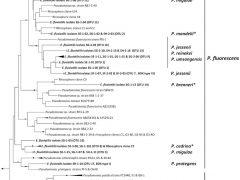Sample was collected from an onion patch at Froberg’s Farm in Alvin, Texas.
Pseudomonas stutzeri ODKF13 is a bacterial microorganism isolated from farmland soil in Alvin, Texas. This strain is notable for its naphthalene degradation and nitrogen fixation pathways and for its characterization as an organophosphate degrader of phosphotriester and phosphorothioate insecticides.
Maximum likelihood phylogenetic tree of Pseudomonas gacA genes.GacA gene sequences of E. fluviatilis-derived Pseudomonas isolates (bold) and of most (>90%) isolates and clones present in relevant databases are shown. In brackets after the isolates’ entries are their corresponding gacA operational taxonomic units (OTU) as inferred by rarefaction analysis at 97% similarity threshold (Fig. 3). Closest type shows the 16S rRNA gene identity of the nearest type strain to relevant tree entries (see Table S1 for a complete list and details). An asterisk indicates 100% 16S rRNA gene similarity between isolates and closest type strains. Phylo group refers to major, super-specific Pseudomonas phylogenetic lineages as determined by Mulet et al. (2010). Open and close circles on tree nodes correspond to bootstrap values 70% and 90%, respectively. The scale bar indicates 5% nucleotide substitution per site. The tree was rooted with the gacA gene homologue of Burkholderia pseudomallei strain K96243.
Image taken from https://www.flickr.com/photos/123621741@N08/14124680981, PLOS ONE Phylogeny, License of CC 2.0 By Deed
Note that this is another independent publication and this sample was not used in relation to that publication

